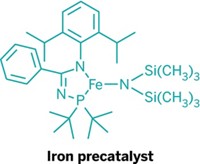Advertisement
Grab your lab coat. Let's get started
Welcome!
Welcome!
Create an account below to get 6 C&EN articles per month, receive newsletters and more - all free.
It seems this is your first time logging in online. Please enter the following information to continue.
As an ACS member you automatically get access to this site. All we need is few more details to create your reading experience.
Not you? Sign in with a different account.
Not you? Sign in with a different account.
ERROR 1
ERROR 1
ERROR 2
ERROR 2
ERROR 2
ERROR 2
ERROR 2
Password and Confirm password must match.
If you have an ACS member number, please enter it here so we can link this account to your membership. (optional)
ERROR 2
ACS values your privacy. By submitting your information, you are gaining access to C&EN and subscribing to our weekly newsletter. We use the information you provide to make your reading experience better, and we will never sell your data to third party members.
Synthesis
Technology Teamwork
June 10, 2013
| A version of this story appeared in
Volume 91, Issue 23
“Hydroformylation’s Diamond Jubilee” was an enjoyable read about the history of hydroformylation technology (C&EN, April 22, page 38). It brought back good memories of the role and importance of the fine and specialty chemicals business in supporting big-volume commodities such as oxo alcohols and other downstream products.
In the late 1980s, the BISBI (bidentate ligand) team at Eastman Texas was developing a new class of phosphines to allow them to fine-tune the normal/iso (N:I) ratio of product. The oxo reaction gives a mixture of isomeric products: the normal (linear) aldehyde and the iso (branched) variant. Although both can be converted into useful products, for most companies the linear version is the preferred isomer. The original cobalt catalyst gave an N:I ratio of 4:1. Addition of phosphines improved this to 8:1.
The research and development group at M&T Chemicals, then in Rahway, N.J., partnered with the Eastman group in a collaborative development project. We had a technology base with commercial-scale Grignard chemistry and expertise in phosphine synthesis. We worked to scale up to commercial quantities of their new bidentate phosphine ligands. It was a pleasure working with the fine and capable group of scientists and engineers from Eastman Texas. Thanks for the memories.
Philip E. Rakita
Hendersonville, N.C.





Join the conversation
Contact the reporter
Submit a Letter to the Editor for publication
Engage with us on Twitter